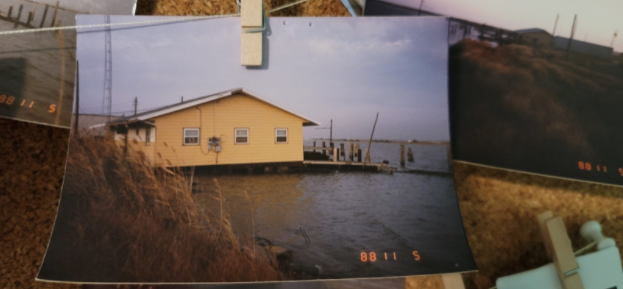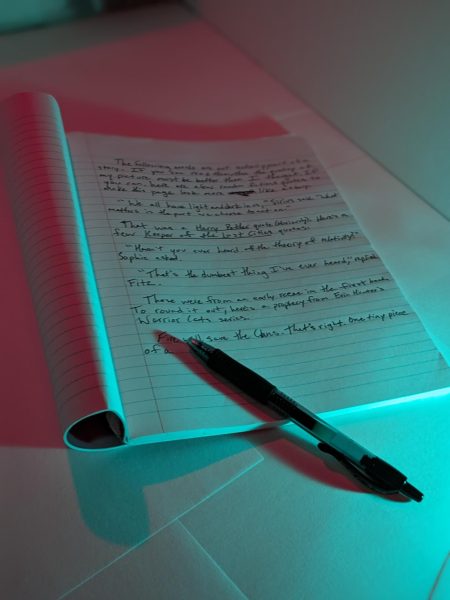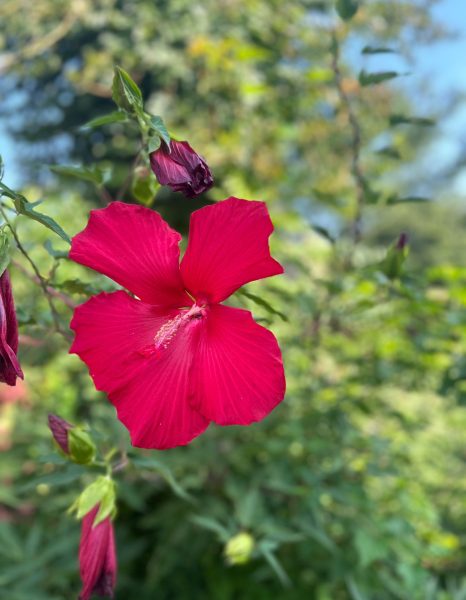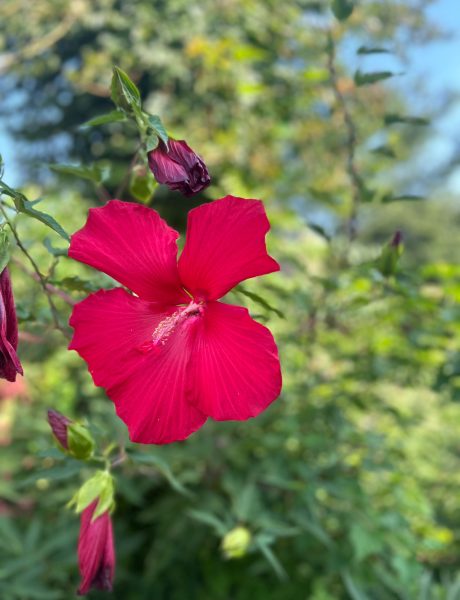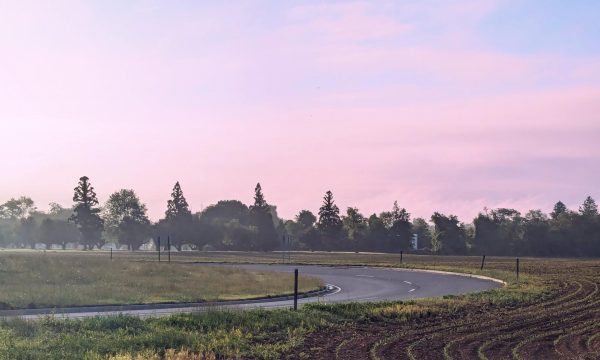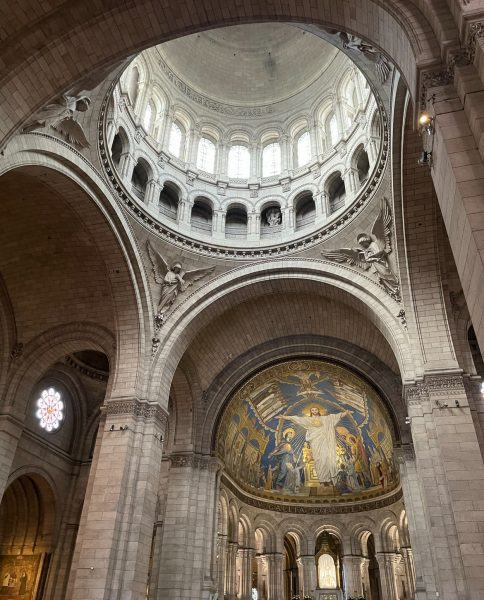A Glimpse of Another Time
The photographs, held up by clothespins clipped along the white, thin string on the corkboard, show images of another time. The string runs from thumbtack to thumbtack, a pattern similar to a zig-zag of squares instead of triangles. Along the string are colored photographs: large-printed photos on the upper portion and small, polaroid photos on the lower portion.
On the corkboard, above the tangled string, is an old, brown, semi-translucent, curled, and short roll of vintage film held up by a pin– the images faded and barely visible. To its right, is an unbent and somewhat faded, printed collage of three photographs, each of them depicting the same location, but two with an indiscernible person. That’s just how it stands for now.
The corkboard, the pinned photos, the string running from pin-to-pin and holding clothespins are curiosities. However, personally, the most eccentric curiosities on that wall are the large, colored images.
The photos portray an overcast sky with a few protruding clouds that contrast with it. It is not certain that it is overcast, as it can just be the color of the late-day sky blended in with most of the clouds, making some of the seams between clouds and sky seemingly indistinguishable. The grey sky is slightly tinted with a bluish tone as the water of the bay leaves its imprint on its surroundings. Due to the weather, the sun is not visible, even though its light is. The amount of light shown in the picture can provide an estimated time of when the image was taken; however, the inefficient focus of the camera and the lack of sun makes it difficult to distinguish or identify the cardinal directions (North, West, East, South). The time of day is, presumably, the afternoon at the earliest, based on the lack of orange shades.
Just below the vast sky, a yellow, rectangular, waterside ranch house at varying angles and points of view can be seen. The home sits just above the water on what appears to be columns of wooden pilings, with only less than half of it supported by the solid, somewhat sandy, and drier land of the shore. The waterfront side of the house has a dock made up of wooden planks, visually aged – a grey-brown wood color.
The pictures show the opposite side of the house to open out to a sandy, marshy, grass-covered land. A thin, sandy path from the land-side front door of the house leads out to what presumably is an unpaved road. The marsh-grass is a pale green, and the bay water a dark, grey-blue. The flora of the area is seemingly pale green as well, but the dimmed sunlight portrays its colors to be more yellow or yellow-brown. Although the water of the bay is mostly calm, it is also just a bit choppy. Stretching out into the bay from the house is a linear pattern of linings spaced out, continuing on out into the water for about four or five meters. The planks that these pilings used to support are now submerged, with only a small part of them remaining visible above the water’s opaque surface.
The house is not completely alone, however. Around the house are more signs of human involvement, and less than half of the photographs show some views of a coastal town far away in the background.
The five-sided, shorter lengths of the rectangular house have yellow horizontal paneling. The longer, four-sided lengths of the rectangular building have yellow horizontal panels on the upper half, but a somewhat white paneling on the lower half. The gable roof is at a low incline on either side, with dark-grey shingles and a white-colored plastic gutter outlining underneath the edges of the roof. The gabled roof runs flat along the top of the longer lengths of the house, whilst its angled edges are seen on the shorter lengths of that house. The side of the roof, which faces towards the land, has a small, short, thin, and circular chimney close to the linear peak of the roof.
The pictures also reveal that the house has two kinds of windows: smaller single-hung ones and larger picture-windows with single-hung flankers. These names describe the visual shape and style of the windows, but the functionality of them – how they open – is unknown. It is not certain that, at this moment, the single-hung windows are not double-hung, storm, or even window pieces similar to awnings or hoppers. They presumably have a window screen covering the outside of the lower window – a white-colored frame with a black-colored outline. Upon closer inspection of the photographs, it is noted that the single-hung windows on the shorter side length of the house have six panes per window.
The five-sided side of the house that faces away from the distant town has these described windows, seemingly evenly spaced apart, with the center opening being just in the midpoint of the wall. On that side of the building, just a little farther and diagonally from the most inland window, are a few small grey boxes attached to the side with three wires running from them: two of the wires run upwards to the roof, whilst one runs down into what appears to be below the ground level of the house. On the opposite side, which faces the distant town, are two windows: one on closer to each side of the wall. On the side closest to the land is, assumingly, a single-hung window with a grey box attached to it, a short distance from the sea-side. Slightly further from the land of the land-side, the window is a dark-colored, flat, square-like shape whose purpose is somewhat difficult to make out just by looking at the photographs.
On the four-sided side of the house that faces the marsh land are two windows, each one closer to an edge of the wall, and a single door stands in between. The window near the direction of the town is a twin single-hung, whilst the other window is a single single-hung. Just under the roof’s edge, in between the door in the center and the single window, is a small rectangular shape whose form indicates it to be an air vent. The doorway is dark, and the quality of the photographs make it quite difficult to conclude whether the color of the door is dark or it is opening to the inside. Underneath the roof’s edge, attached to the wall a short length away from the “town-edge” of the door, is a box that visibly sticks out just enough to be half the length of the roof’s overhang from the wall. Presumably, it is the air conditioning system; however, due to its vague details, it might serve a different function.
On the rectangular wall that faces the water are four windows and a single door. On the half that is further from the town’s direction, two single-hung windows are spaced apart from each other. On the half that is closer to the town, two picture windows with single-hung-flanker windows, separated by another door, are depicted. Though not as spaced out from one another as the other single-hung windows, the three features of the town-side half are not connected to one another, edge-to-edge; rather, they have a small distance between them. The center door frame is slightly elevated from the wooden deck, but not drastically as to cause serious complications. The door itself – or, at least, the visible, outer one – is a white, made up of presumably plastic or metal, with two separate, dark screens on the upper two thirds.
The waterfront wooden deck on the water-facing side of the house has planks, which are aligned perpendicularly to the general “line” of the shore. The deck rests on seemingly multiple, wooden pilings. Some slight discoloration reveals that the planks were both commonly used and weathered by the bay’s climate and water – not freshly new.
Nestled against the wall of the house on this bayside deck are two light grey metal tables; nestled against them are more extra wooden planks, aligned and stacked in a rectangular pile. Beside the table and planks (on the side closer to the town) are tanks – presumably, tanks of some type of gas. On the opposite side of the door from these three things, is a wooden bench that is no higher than the first rung of a ladder.
From the deck, along the water side, are three pilings spaced apart, notably having a somewhat thin, white, almost yellow-colored rope tied from piling to piling, extending outwards. On the inland side of this deck, the edge closer to the town, is a single long wooden plank, which rests one end on the house deck and the other on a separate, arguably newer deck – this one with a rail on the sides that looks to be used for holding. This separate deck sticks out from the land out into the water – buoyant like those plastic docks – like a darker, smaller version. The small ripples and ebbs of the water’s surface beat against and around the pilings, most of which stand alone, apart from others, with only a few holding up either the single plank, the water side of the house’s deck, or the small dock.
On the inland side of the house is that thin, sandy path mentioned earlier, which looks to extend from the “front” door of the house to intersect nearly perpendicular to a larger, seemingly unpaved road. Along the sandy path are seven small pieces of plastic litter, most of them milky in color. On the land, near the side of the house which is farther from the town, is a tall, metal antenna with a triangle-shaped base. The photographs don’t clearly show what is at the top of the antenna, with most clear-depictions of the antenna in the photographs cutting it off from view halfway up.
Inland from that antenna is a vehicle. The vehicle is dark in coloration, and its form resembles an old-fashioned dump truck due to its visible, inner seats where the driver and passenger sit and a horizontal-panelled dump-body. The car seems to sit low in the vegetation; grass covers the surface, overgrowing where the ground is. The photographs do not show the wheels– they are hidden by the grass.
On the side of the house closer to the town, some of the photographs depict a white, metal shipping container, with vertical wall panellings on at least one side. The length of the container appears to be about one-and-a-half times longer than the length of the house. A bit farther from the building, but still very close to it in regards to the distance from the distant town, is a yellow-colored… thing (yes, thing). It is large, but a third of the size of the shipping compartment. It is a dark, yellow color and has a black, metal, rung-like box attached to one of its sides.
Along the sandy road are the silhouettes of telephone poles. From each telephone pole runs at least one wire (based on the photograph). In the background, between the town and the house, underneath a telephone pole, is a medium sized, barn-red-colored object with a black-colored, flat top. The lower portion of the said-object is not visible as the “field” of marsh grass obstructs the view, but from its top half appears to be some type of vehicle.
The waterfront town in the background is shown to be made up of a lot of white-colored buildings. A large building, closest to the house amongst the other buildings of the town, looks to have white-colored walls and a roof with a shade lighter than that of the roof. Just behind this large building appears to be an even taller antenna, rising high above the near sea-level ground of the region.
Floating on the bay, along the waterfront of the town, there are at least three boats/ships, which appear to be utilized for the harvesting of some sort of marine food, presumably fish or shellfish. The closest ship has a white body and outside of a room above the deck. The second closest among these three ships has a dark-colored keel and a white-colored gunwale, with three up-reaching beams/poles of indiscernible color, shape, and positioning. Farthest among the three notable boats is a boat with a noticeably red crosstree.
The town stretches quite far along the coastline of the bay; some of the buildings and houses have visible artificial lights that are as bright as soft, light-colored dots. Far behind the town, are two different horizons: on the inland side of the horizon is a thin, darker, line of what is presumably coastal trees; and on the water side of the horizon is another one– a very flat, save for a few very thin, short strips of white that are most probably towns or boats. On the opposite side of the house from the town is a flat horizon as well, with no further visible structures than the nearby subject of the photos– the yellow house.
Across the body of water from the house and town is another shore, similarly grassy to the closer side. Though this other side of the water has some signs of human structures, there is notably way less man made obstructions on the farther side of the water than on this, closer, side. The location of the home itself on this bay; though, there is much more visual evidence that hints it being positioned further from the sea than the opposite side.
Regarding the physical photographs themselves, they are in-color photographs on a card-like paper. There are seven of them, rectangular in shape as the horizon in the images are parallel to the length of the photographs. They are slightly curved along the widths, and yet their lengths are straight. On the lower right-side corner of the photographs are three numbers: 88 11 5. Each digit– each grouping– is separated by equal spaces (in this case, 8, 1, and 5). The numbers are a neon-orange or neon-red in color, and they are in a liquid, crystal display font, similar to the number style of many digital clocks.
The color side of the photograph has a smoother, almost smooth-plastic like feel, while the back of the photographs has a more paper-like feel. The backs of each photograph are white in color, and the edges are subtly stained with age. Faintly printed in a pale grey on the back are the words: “THIS PAPER MANUFACTURED BY KODAK.” The text is repetitive, each phrase spaced apart from another, in a diagonally lined, near hemi-grid-like pattern. In the center, stamped in faded, blue ink on the back are two words: “DEC 1988,” with a circular stamp mark above it reading “Kodak Colorwatch System” in the same faded faint blue ink, but much more blurry and faded by comparison to the date. They are more faded on some photographs than on others, some even being near-illegible.
Each image has the same text, stamp, and digits on the backs of it. The neon text on the front corner implies that they were all taken on the same day. And, according to the date included, the event was supposedly on November 5th, 1988 as the order of the date on such photographs goes as year, month, day (and so, “88 11 5” becomes 11/5/88). This assumption is further supported by the date (rather) physically stamped on the back of the photos: December 1988. This suggests that the images were taken the month before December when they were printed using a Kodak Colorwatch System.
Discovered a few years ago in southern New Jersey, among the remains of a place amidst a littered, forested, overgrown field, I haven’t been able to tell exactly where the photos depict. Could the location really be from someplace in New Jersey? I only assume this outcome to be one of high probability based on where I found them. If so, then, what part of NJ? Which bay? Perhaps not even a bay, but where a river meets saltwater? Again, and if so, then, which one? Where? That mystery of where they are (from) beckons me– keeps me thinking and wondering and pondering. Each time my eyes meet the corkboard stuck to my wall, I see them, and I am reminded of what they mean to me– the memories of the past, who I am in the present, and where I could be in the future. I really wish I could find the location that the captivating photos depict, and, perhaps, I could.
Perhaps, this summer?

